Delve into the biblical term 'kine' to uncover its profound symbolism and cultural significance in ancient times—discover more within.
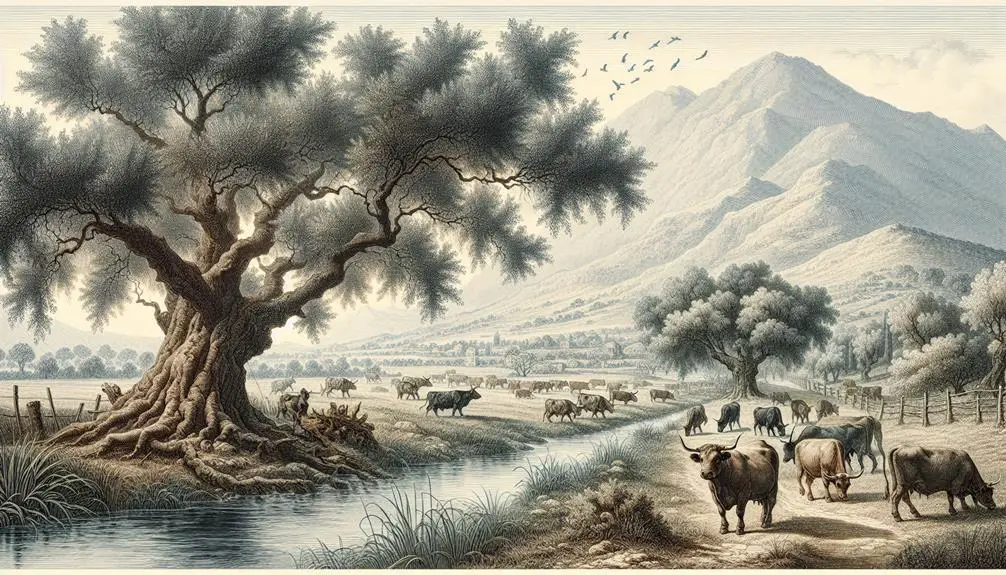
What Is Kine in the Bible
Venturing into the ancient texts of the Bible, you'll find the term 'kine' peppered across its pages like stars in the night sky, sparking curiosity about its significance.
This archaic term for cattle holds more than just a literal meaning; it represents a wealth of symbolic and cultural importance in biblical times. From historical usage to agricultural significance, understanding 'kine' sheds light on ancient societal values and their relationship with the environment.
As you explore the symbolic meanings and cultural impact of kine on ancient societies, you'll uncover layers of meaning that reveal how deeply interconnected humans and their livestock were in shaping the world of the Bible.
Key Takeaways
- "Kine" is the archaic plural form of "cow" used in the Bible, reflecting ancient agrarian societies' reliance on cattle.
- Mentioned in various biblical contexts, kine symbolize wealth, social status, and are central to survival in ancient times.
- The interpretation of kine in biblical texts can offer insights into the socio-economic and environmental landscapes of the Near East.
- Kine's significance in the Bible extends beyond the literal, contributing to symbolic meanings in dreams and religious ceremonies.
Historical Usage of Kine
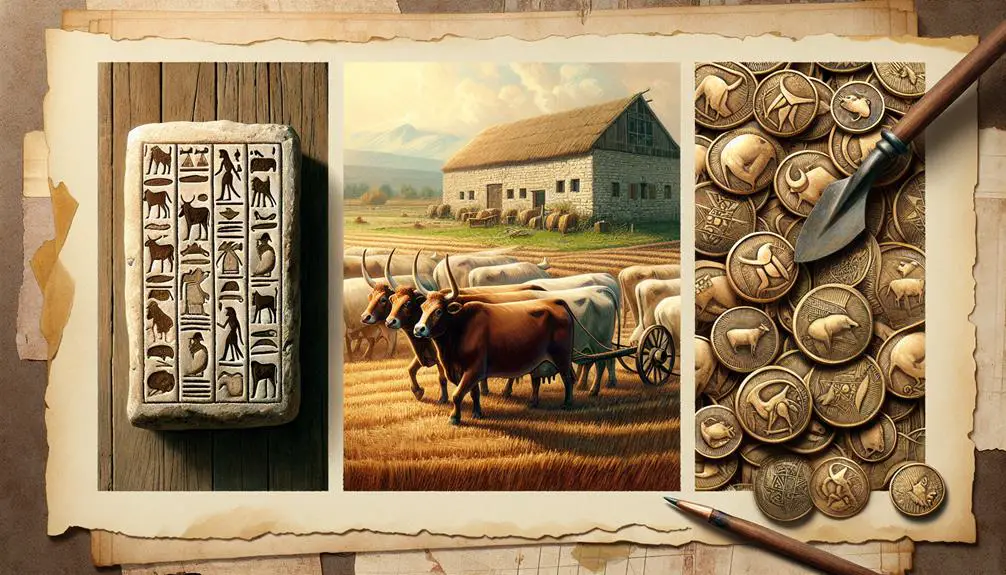
In exploring the historical usage of 'kine' in the Bible, one finds that this term serves as an archaic plural form of 'cow,' reflecting the agricultural practices and livestock management of ancient times. Delving into the etymology of 'kine' illuminates its roots in Old English, where it was originally spelled 'cy,' then evolving into 'kye' in Middle English, before finally settling into its modern form. This linguistic journey underscores the term's deep-seated role in the agrarian societies of the past, where cattle were central to survival and wealth.
The mention of 'kine' in biblical texts isn't merely incidental; it's emblematic of the vital role these animals played in the ancient world. Cattle were indispensable for their milk, meat, hides, and as draft animals. Understanding the types of cattle, or 'kine,' referred to requires a look into the ancient breeds that would have been prevalent in the Near East and surrounding regions. These wouldn't have been the highly bred varieties familiar today but rather hardier, less specialized breeds adapted to the harsher conditions of the time.
The historical context of 'kine' in the Bible, therefore, opens a window into the socio-economic and environmental realities of ancient societies. By examining the etymology of 'kine' and considering the characteristics of ancient cattle breeds, one gains insight into the significance of these animals in biblical times. This analysis not only enriches one's understanding of biblical references but also highlights the enduring connection between humans and domesticated animals throughout history.
Kine in Biblical Passages

Having explored the historical significance and etymology of 'kine,' we now turn our attention to their appearances in biblical passages, where these animals often carry symbolic and literal importance. In the King James Version of the Bible, 'kine' are mentioned in various contexts, highlighting their role in agricultural life and religious symbolism.
One notable instance is in Genesis 41, where Pharaoh's dream of seven fat and seven lean kine stands as a pivotal narrative, forecasting seven years of abundance followed by seven years of famine. This passage not only underscores the economic importance of cattle in ancient Near Eastern societies but also illustrates how translation variations can affect interpretation. The term 'kine,' an archaic plural for 'cow,' is used in older translations, while modern versions may simply use 'cows' or 'cattle,' potentially altering the reader's perception of the text's historical context.
Furthermore, geographical references associated with kine in the Bible offer insights into the environmental and cultural landscapes of the times. For example, references to grazing lands in Numbers 32, where the Reubenites and Gadites request lands suitable for their large herds, highlight the importance of pastoralism in these regions. Such passages not only document historical livestock management practices but also reflect the socio-economic priorities of ancient communities.
In examining kine within biblical passages, it's crucial to consider both the literal and figurative layers of these texts. While the direct references to cattle farming practices provide a window into daily life, the symbolic uses of kine reveal deeper spiritual and prophetic messages embedded within the scriptures.
Symbolic Meanings of Kine
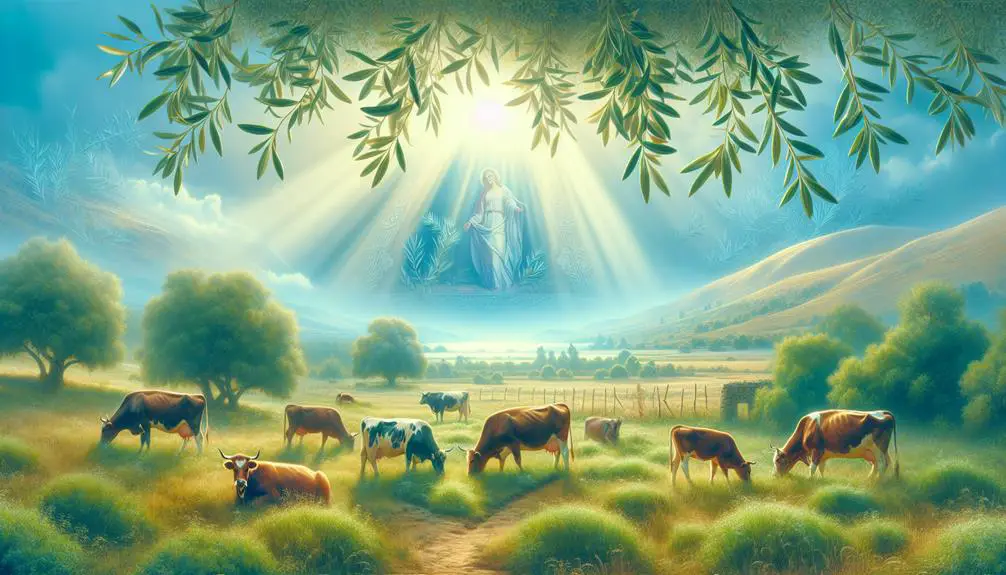
Delving into the symbolic meanings of kine, you'll find that these animals embody a rich tapestry of spiritual and economic significance throughout biblical texts. In the realm of dream interpretations, kine often appear as potent symbols. For instance, Joseph's interpretation of Pharaoh's dream, where fat and lean kine represented years of abundance and famine, respectively, underscores their role as harbingers of societal welfare and divine messages. This narrative not only highlights the prophetic nature of dreams but also illustrates the kine's role as a medium through which divine will is communicated.
Moreover, kine's participation in religious ceremonies further cements their symbolic import. Their use in sacrifices, as outlined in Levitical laws, signifies purification, atonement, and the establishment of a covenant between the divine and the Israelites. This sacrificial role imbues kine with a sanctity that transcends their material value, elevating them to instruments of divine grace and mercy.
Analyzing these instances, it's clear that kine weren't mere livestock within the biblical context; they were vessels of deeper spiritual and socio-economic symbolism. Their appearances in dreams and religious rituals were laden with meanings, from foretelling national crises to facilitating sacred rites. This dual role underscores the multifaceted significance of kine, as they navigate the boundary between the earthly and the divine, echoing the intertwined nature of daily life and spiritual existence in biblical times.
Agricultural Importance of Cattle
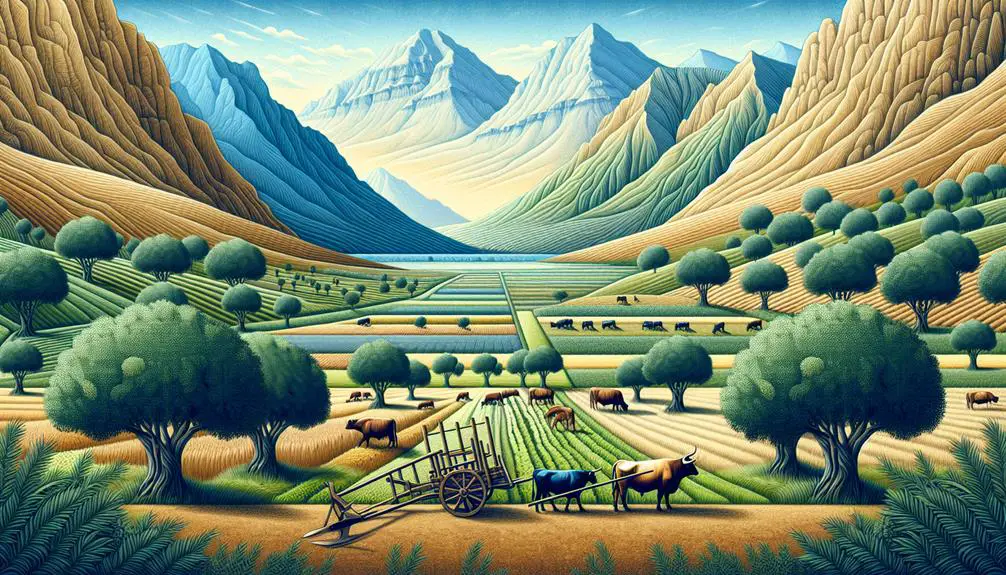
Beyond their symbolic representations, cattle held a pivotal role in the agricultural framework of biblical societies, fundamentally shaping their economy and daily life. They were indispensable in fields such as plowing and transportation, reflecting an era where the dependence on animal labor was crucial for survival and development. The breeding and care of cattle, therefore, received considerable attention, with strategies and knowledge being passed down through generations, marking the early foundation of what would evolve into modern breeding techniques and disease resistance strategies.
These practices weren't merely about sustaining the cattle population but were pivotal in ensuring the prosperity and continuity of communities. The health and productivity of cattle directly influenced the agricultural output and the overall well-being of a society. This deep interconnection highlights the significance of cattle beyond their immediate utility, pointing towards a relationship that was symbiotic and integral to the societal fabric.
To underscore the importance of cattle in biblical times, consider the following:
- Labor: They were primary sources of labor for plowing fields and transporting goods, essential for agricultural and economic activities.
- Food production: Cattle were a key source of meat, milk, and other dairy products, contributing significantly to the diet and nutrition of societies.
- Economic assets: Owning cattle was a sign of wealth and social status, playing a central role in trade and dowry systems.
- Agricultural development: The evolution of breeding practices and disease management laid the groundwork for modern agricultural advances.
This analysis reveals the multifaceted role of cattle in biblical societies, highlighting their contribution to the agricultural, economic, and social realms.
Cultural Impact on Ancient Societies
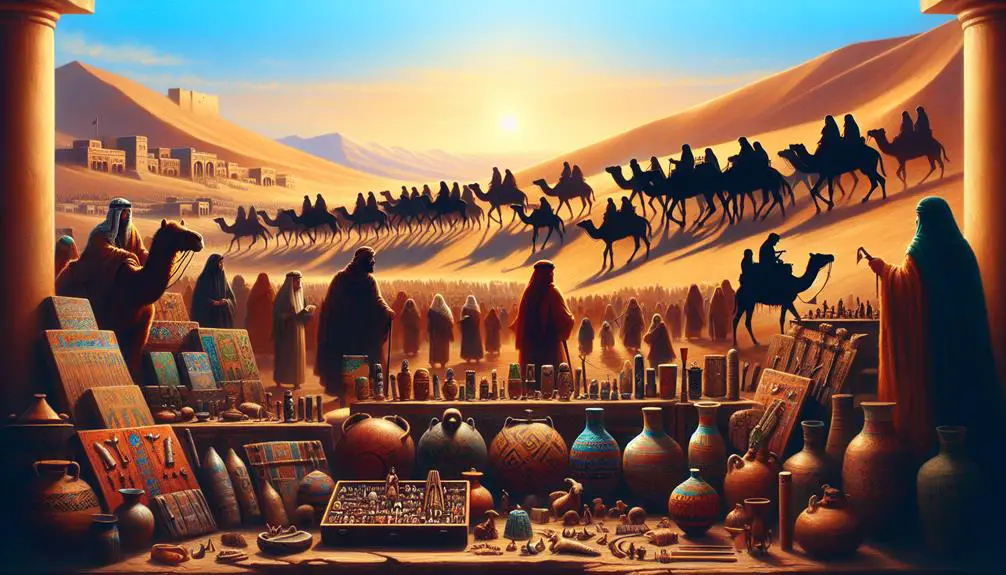
Cattle's role in agriculture naturally extended to profound influences on the cultural fabric of ancient societies, shaping rituals, social hierarchies, and even mythologies. You'll find that as cattle became central to agricultural success, their significance transcended mere economic value, embedding deeply into the cultural consciousness of various civilizations. This integration manifested in several key areas, notably in religious practices and the establishment of trade routes.
Religious practices in numerous ancient cultures revered cattle as sacred beings or as indispensable offerings to deities. You'd observe that in ancient Egypt, for instance, the bull was venerated as an incarnation of Apis, symbolizing fertility and strength. Similarly, in Hindu culture, cows are still considered sacred, reflecting an enduring legacy of ancient religious reverence for cattle. These religious practices not only underscored the spiritual significance of cattle but also reinforced social norms and values, promoting a sense of unity and shared identity among the community members.
Moreover, the necessity for cattle in agricultural and religious contexts spurred the development of extensive trade routes, which facilitated cultural exchanges and economic prosperity. You'd note that these trade routes became conduits for the spread of ideas, technologies, and religious beliefs, further amplifying the cultural impact of cattle on ancient societies. Through trade, cattle-related products and cattle themselves were exchanged, linking distant communities and contributing to the complexity of social networks.
In analyzing the cultural impact of cattle on ancient societies, it's clear that their role extended far beyond the fields; they were instrumental in shaping the very foundations of civilization, from religious practices to economic structures, through the establishment of trade routes and beyond.
Frequently Asked Questions
How Do Modern Translations of the Bible Interpret the Term "Kine" Compared to Older Versions, and What Implications Does This Have for Contemporary Understanding?
You're exploring how modern Bible translations interpret 'kine' versus older versions, focusing on translation accuracy and linguistic evolution. This comparison sheds light on the implications for today's understanding.
As languages evolve, so do interpretations of ancient texts. Modern translations aim to maintain fidelity to original meanings while making the text accessible to contemporary audiences.
This process reflects the dynamic nature of language and the ongoing effort to bridge historical contexts with modern comprehension.
Are There Any Significant Discrepancies in the Depiction of Kine Across Different Biblical Translations and Manuscripts, and How Do Scholars Reconcile These Differences?
You're delving into textual criticism, examining manuscript variability to spot discrepancies in how kine are depicted across different biblical translations. Scholars employ a rigorous, objective lens to reconcile these differences, analyzing linguistic nuances and historical contexts.
This scholarly endeavor ensures a more accurate interpretation, bridging gaps between ancient texts and contemporary understanding. It's a deep dive into the fabric of religious texts, highlighting the evolution of language and meaning over centuries.
How Has the Interpretation of the Biblical Role and Symbolism of Kine Evolved in Theological Studies Over the Centuries?
You've witnessed theological shifts mold the interpretation of kine symbolism, much like rivers shape valleys. Initially, kine represented tangible wealth and divine blessings.
Over centuries, scholars have peeled back layers, revealing complex symbolisms tied to sacrifice, providence, and judgment. This evolution reflects broader theological currents, redefining kine's role from mere livestock to multifaceted symbols in religious discourse.
Analyzing these shifts offers a window into the dynamic nature of biblical interpretation.
In What Ways Have Non-Biblical Ancient Texts and Archaeological Findings Contributed to Our Understanding of the Significance of Kine in Biblical Times?
You'll find that non-biblical ancient texts and archaeological discoveries have significantly enriched our understanding of kine's role in biblical times. These sources shed light on ancient diets, revealing how kine were integral to nutrition and religious rituals.
Additionally, they highlight the importance of trade routes in the distribution of cattle, illustrating how kine influenced economic and social structures. This evidence offers a broader context for interpreting kine's biblical significance.
What Are the Ethical and Theological Debates Surrounding the Treatment of Kine and Other Livestock According to Biblical Teachings in the Context of Modern Animal Welfare Concerns?
You're exploring how biblical teachings on the treatment of kine and livestock intersect with modern concerns about animal rights and ethical farming. This debate delves into whether ancient scriptures provide guidance that aligns with or challenges contemporary views on animal welfare.
It's crucial to analyze these texts within their historical context while considering how they can inform current ethical discussions on the humane treatment of animals in farming practices today.
Conclusion
In conclusion, you've seen how kine, like threads in a tapestry, weave through the biblical narrative, symbolizing wealth, power, and divine providence.
Their agricultural significance can't be overstated, nourishing ancient societies both physically and economically.
Moreover, the cultural impact of cattle in these narratives underscores their integral role in shaping the socio-economic structures of the time.
This exploration reveals the profound ways in which kine contributed to the foundational stories and practices of ancient civilizations.



Sign up